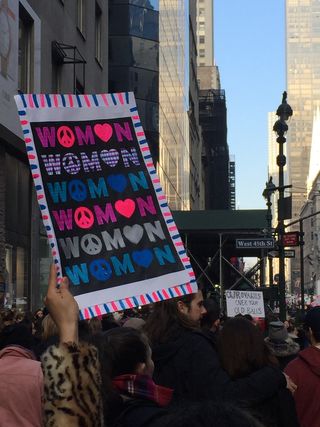
Source: Amanda Hirsch from Brooklyn, NY, USA - Women power, CC BY 2.0
How many women are not totally straight?
Across all countries in which we have sufficient data on sexual orientation, straight-identified women are the second largest group—only slightly smaller than straight men in most national surveys. According to a cross-national survey of 28 countries, they compose about 90% of the female population, and the percentage is likely higher in countries with traditional notions of femininity that discourage engaging in same-sex behavior. Remember, however, this is when women are only given bisexual and lesbian as alternative identity categories and when they are not asked who they are sexually attracted to or who they have sex with.
Is this 90% an overestimation? Yes, as it is among men, but even more so. When women are given identity options beyond the traditional three (straight, bisexual, lesbian), a large number will choose straight even though they know this is inaccurate; if, however, they are given more non-straight options, such as mostly straight, pansexual, queer, fluid, questioning, or asexual, they commonly choose one of these because they more adequately reflect their sexuality, romantic desires, and gender preferences.
In addition, when sexual orientation is assessed not by identity but by sexual attraction or sexual behavior, the proportion of purely straight-identifying women decreases dramatically. For example, in the cross-national study noted earlier, just 66% of women reported being “predominantly not attracted to the same sex.” This group likely includes straight women and at least 24% (90% minus 66%) who have a slight degree of dual attraction but who reject a bisexual identity label as too same-sex oriented for them. If given the option, these women would likely have chosen something else. Corroborating data are available in two 2012 studies of U.S. and British young adult women: 16% and 13%, respectively, reported “more often opposite-sex attraction but some same-sex attraction.”
In terms of sexual behavior, similar trends are evident. In the British study, 15% of young adult women reported “more often opposite sex, and at least once same sex.” This percentage was far greater than the 6% for older women (ages 35-74). These findings are commonly reported in other national studies across countries: that is, a low but not insignificant number of straight-identified women have had sex with women, and this is more common among younger generations.
Summary
Many women report a significant degree of sexual attraction and/or behavior with other women and yet identify as straight because it is the closest identity option available in our surveys. Thus, it is somewhat difficult to determine the true size of the population of straight-identified women who are not totally straight. But we do know that the proportion is considerably larger than it is for men who are willing to admit to being not totally straight. If we were to routinely give women multiple options or an open-ended question to identify their sexual orientation (including “none”), my guess is that the number of straight-identified women would decrease dramatically.
Why are these women not totally straight?
We really do not know, but we know they exist. Here are several hypotheses ordered from least to most likely, according to my understanding of the literature.
1. All women are born bisexual and are receptive to psychological and social messages that begin at an early age. These may be pro-femininity (attracted to men) or anti-femininity (attracted to women). (traditional psychoanalytic)
2 Women don’t have a biologically based sexual orientation and thus are responsive to contemporary cultural and social forces. (Bailey)
3. Women’s bodies are ubiquitously eroticized in popular media and therefore women may be doing the same when viewing sexual stimuli depicting women. (Chivers)
4. Women demonstrate an erotic plasticity and are responsive to external influences such as social, cultural, and other contextual factors (similar to #2 but the erotic is biological). (Chivers)
5. Women are in touch with their emotions and bodily sensations such that they are sensitized to a range of erotic stimuli, regardless of biological sex or gender expression. Because women are less susceptible to social or cultural stigma toward same-sex sexuality than men are, they are freer to pursue independent pathways. (Savin-Williams)
Bottom Line
Although I can’t tell you with certainty how many not-totally-straight-but-identifying-as-straight women there are, it’s likely, at the present moment, to be higher than the rate among men and lower in older generations. My best guess is that over 50% of the U.S. female population is totally straight, the largest sexual-orientation group among women.
If so many women (and men) have some degree of same-sex attraction and behavior, what is with negative attitudes toward those who incorporate these facets into their identity?
"Many" - Google News
January 31, 2020 at 03:07AM
https://ift.tt/38PRc7J
Why Are So Many Heterosexual Women Not Totally Straight? - Psychology Today
"Many" - Google News
https://ift.tt/2QsfYVa
Shoes Man Tutorial
Pos News Update
Meme Update
Korean Entertainment News
Japan News Update
Bagikan Berita Ini














0 Response to "Why Are So Many Heterosexual Women Not Totally Straight? - Psychology Today"
Post a Comment